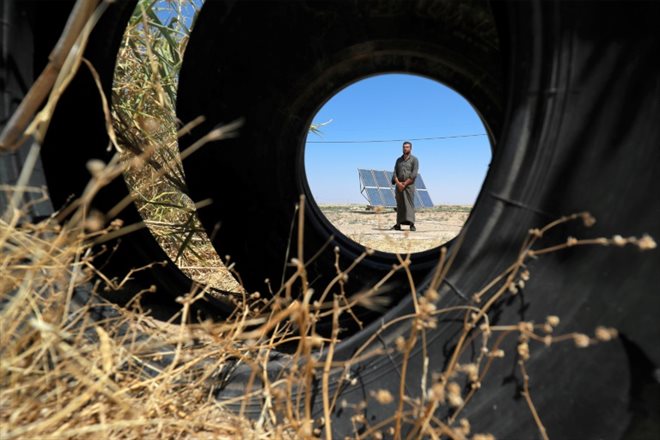A man holds a shovel in a watermelon field near solar panels used to power field irrigation on a farm in the village of Al-Haddadiya in northeast Syria, September 24, 2023 (AFP/Delil SOULEIMAN )
In the north-east of Syria, the country’s former breadbasket, solar energy has provided a lifeline for farmers, allowing them to irrigate their crops damaged by drought and electricity shortages.
“Solar energy saved agriculture and farmers from extinction,” assures Abdallah al-Mohammed as he adjusts a large solar panel in his flowering cotton field in Hassaké province.
Three years ago, following a drought that threatened cotton, wheat and barley fields, this 38-year-old man installed dozens of solar panels, just like the other farmers in his village. by Al Haddadiya.
Solar energy allowed him to irrigate his crops “because there was no electricity” to operate the pumps, “nor fuel oil” for the generators, explains this father of three children. “We are trying to bring life back to our land.”
The region controlled by the autonomous Kurdish administration was once the country’s breadbasket, before the government suppressed a popular uprising in 2011, triggering a conflict that left more than 500,000 dead and displaced millions.
The state now provides barely four hours of power a day, as the conflict has ravaged the country’s infrastructure, while a rise in fuel costs has impacted farmers.
Rising temperatures and falling rainfall have added to farmers’ woes.

Children stand near solar panels used to power field irrigation, and watch as a farmer waters a field of watermelons on a farm on the outskirts of the town of Hasakah in northeastern Syria on September 24 2023 (AFP/Delil SOULEIMAN)
Previously, “we found water 30 meters away”, but today we have to dig 60 meters to find it, making irrigation more difficult, explains Abdallah al-Mohammed.
Northeast Syria could experience periods of drought every three years and precipitation is expected to decrease by 11% over the next three decades, according to a report by the NGO iMMAP published in 2022.
– Survival –

A sunflower is pictured in front of a watermelon field, where solar panels used to power irrigation on a farm in the village of Al Haddadiya in northeastern Syria, September 24, 2023 (AFP/Delil SOULEIMAN)
Between 2011 and 2021, the Syrian state’s electricity production “fell significantly, to almost 57%,” according to a 2022 United Nations report, pushing Syrians to seek alternatives.
The agricultural region of Hassaké is now dotted with thousands of solar panels, dominating land, homes and businesses.
Ten kilometers from Al Haddadiya, Hamid al-Awda, installed 272 solar panels on his vast agricultural land.
“Farmers who cannot afford to use solar energy and generators have seen their crops wither,” this 60-year-old man told AFP as he irrigated his fields.
For him, as for other Syrian farmers, the use of renewable energy is a question of survival and not an environmental concern.
It uses solar energy to pump water from groundwater, which is diminishing, he explains.
Using solar power, he has planted four hectares of cotton and hopes to be able to produce a sufficient harvest of wheat and barley during the winter.
The contrast between its green field and the dry grass due to lack of irrigation a few meters away is striking.
Further north, near the Kurdish town of Qamichli, Mohammed Ali al-Hussein says that when he had to wait several days to get fuel, the land dried up.
“Today, we water the land from morning until evening, thanks to solar panels,” adds this 22-year-old young man who is trying to preserve the land inherited from his father. “In addition, this system is quiet, does not break down and does not require fuel.”
– Waste –
However, iMMAP warned of the environmental cost of relying on photovoltaics in Syria.
According to the report, “water pumps powered by solar energy… are responsible for an increase in extraction which leads to a decline in the water table.”
An observation shared by Didar Hasan, of the solar energy company Wanlan, according to which “people will continue to depend largely on solar energy” in the years to come, “not because it is renewable (… ) but because they need electricity.

A Syrian farmer, Mohamed Ali al-Hussein, 22, stands near solar panels used to power irrigation of fields on a farm on the outskirts of the town of Hasakah in northeast Syria, on September 24, 2023 (AFP/Delil SOULEIMAN)
Most of the equipment available is either “used and worn panels, imported from Europe” or of poor quality, he believes.
Such equipment has a lifespan of a few years, he explains. “After that, we will be left with tens of thousands of unusable solar panels, essentially waste,” in a region without adequate facilities to process them.
© 2023 AFP
Did you like this article ? Share it with your friends using the buttons below.




